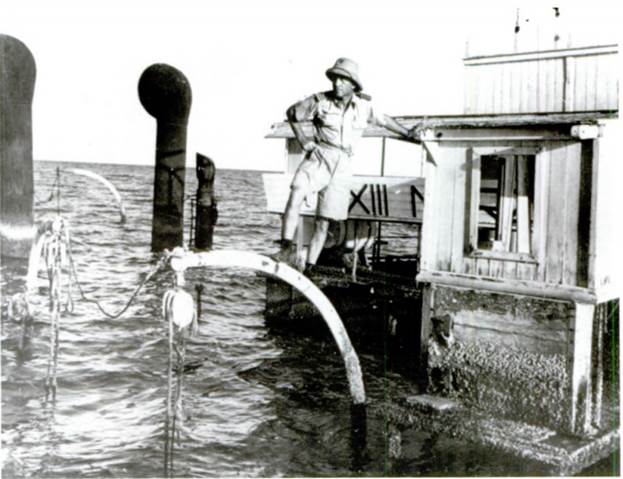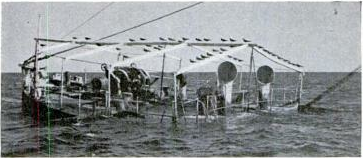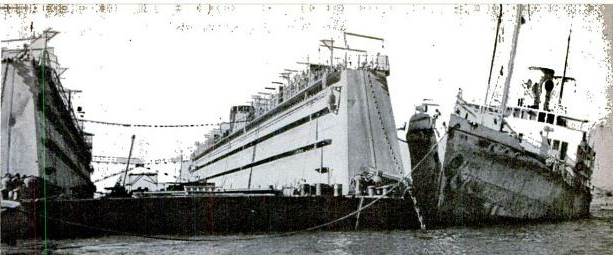[This is the last part of a three part series, part 1 and part 2 have already appeared on this blog. Read on after the break.]
Massowa was an Italian naval base built by Mussolini to attack Ethiopia. It had been bombed, and ships were sunk in the harbor. Ellsberg’s assignment was to make Massowa useful, as it was the only harbor that could support the British Fleet in the Mediterranean. The nearest drydock and repair station other than Massowa was in South Africa, 4000 miles away. When the British had conquered Massowa, the defeated Italians had wrecked the repair shops and smashed the machines with hammers, bombed and sank the two drydocks that were used for repair and overhauling, and sank 26 Axis ships in the harbor to make it unusable. Then they took away all the tools.
 |
| Capt. Edward Ellsberg surveying the harbor of Massowa from a sunken wreck |
 |
| One of the many Axis vessels sunk at Massowa, Eritrea |
Some British experts thought that Massowa could not be salvaged quickly. Ellsberg spent the first few weeks before going to Massowa putting together a salvage organization. All the Navy divers were busy in Pearl Harbor, and could not be spared. He went to Hollywood, where he hired five divers from film companies that made underwater movies. This was his crew.
While waiting for tools to arrive from the US, Ellsberg salvaged what he could locally. His crew requested each ship that came into the harbor to give them any tools, even a hammer or a screwdriver! He drove 80 miles to get a couple of handsaws, and recovered some electric motors from an abandoned gold mine in the hills. He found that the Italians had not smashed everything – by matching up the undamaged parts from each motor, they could get power generation started at twenty five percent of the original capacity. They set up a crude foundry to replace the broken parts. Within two months, nearly every machine was back in operation, before any of the new machinery had arrived from the US.
The heat at Massowa was unbearable. The sea water was so hot that swimming was not possible. The iron plates on the ships reached temperatures up to 160⁰ F. Metal tools could not be lifted without gloves, and even then had to be dunked in the water first to cool them off. Dehydration was a major problem. Taking advice from Army officers in the area, Ellsberg decided to emulate the steel workers in Pittsburgh, and ordered salt tablets distributed at regular intervals among the salvage workers by Eritrean water boys. In spite of these precautions, the heat and dirt had severe impact on health – one-fourth of the crew was in hospital. At about this time, the divers from Hollywood arrived.
The most important vessel to raise was a massive drydock that had been sunk in the middle of the harbor. The Italians had exploded bombs inside the drydock to sink it. The British had written it off as unsalvageable. “
“I kept thinking about that drydock. The British reports told me about the damage it had received. We had two diving suits and I went down myself to test an idea I had. I believed if all the damage was in the base, and the two sides had not been perforated, there would be enough buoyancy in the two sides to raise the drydock even though the base was filled with water and silt.
With three old air compressors, we began working. In five days we had the drydock two-thirds up. There were eight compartments along the bottom and they had placed bombs in each unit, seven of which had exploded. A diver was able to get inside the eighth unit through a manhole and carefully remove the unexploded bomb.
This left a seated compartment on the end which we could raise by air pressure. Using the domino concept, by raising the end one we could get to the next one und seal it and then raise that and get to the next one and so on. In nine days the whole drydock was afloat and the holes temporarily patched with wood.”
 |
| The sunken drydock at Massowa, Eritrea, that was salvaged by Commander Ellsberg’s team |
With the drydock working, the rest of the work was a lot easier. He kept raising the sunk vessels and repairing them, till the point there was no place to put them. With the British supply ships backing him, Field Marshal Montgomery stopped the German advance at El Alamein. Eisenhower landed at Casablanca, and the German Field Marshal Rommel was caught between two armies. During this time, Ellsberg lost forty pounds in weight.
With things running smoothly at Massowa, Ellsberg was ordered to fly to the Mediterranean. He flew to Algiers, where he found things in a mess. The Vichy French had sabotaged their own ships all along the African coast rather than let them fall into Axis hands. The French Naval base at Oran needed to be unblocked. Three big drydocks had been sunk – one was three times bigger than the one at Massowa. Under air attack, he and his team managed to repair the drydocks and start repairing ships.
After a medical checkup, the doctor ordered him to get out of the war zone and rest. He was sent home to Bethseda where tests proved he was suffering from battle fatigue and needed a good rest. He got a month’s leave, and after the leave was over, he was appointed as chief inspector of forty shipyards in the New York City area.
After a year of duty and rest, he wanted to get back into the action. He went again to Adm. King, who pointed to a map on the wall and asked him to pick his assignment. Ellsberg knew they were getting ready for the European invasion and wanted to be part of that. With a letter from King, he flew to London to report to Adm. Harold Stark. Stark wanted him to review the overall plan for Operation Overlord, from the planning stages of the invasion through the landing and the subsequent operations.
The biggest problem with the invasion was that the Germans controlled every harbor in Europe from Norway to France. The Allies couldn’t land unless they could support the troops with arms, ammunition and supplies. The plan they finally decided on was to build two artificial harbors in pieces and tow them across the English Channel, where they could be reassembled and used. Operation Overlord depended on these harbors, and British engineers had been working for a year on the problem.
Navy Capt. Dayton Clark, whose responsibility it was to get the harbors assembled, appealed to Ellsberg. He believed that the pieces could not be lifted off the English beach.
“Getting the harbor pieces off the beach would be similar to a salvage operation. The operation would be the equivalent of raising eight Normandies (the luxury liner) in a three-day time limit. There were 100 pieces, each weighing 6,000 Ions. Raising each of them would be like raising a sunken ship.
I found the British hadn’t had a test run and didn’t intend to. They were entirely confident they’d raise them successfully for D-Day. I knew from looking at the equipment they planned to use that it positively wouldn’t work. I talked the British officer ¡n charge into showing me how it would be done, using one of the pieces. They got this pump as big as my living room and began to pump. After four hours of pumping, not one gallon of water had been pumped out.
D-Day was near and the U.S. Army was depending on artificial harbors which would never get to Omaha Beach! The men would be massacred. ¡ urged the job had to be given to the US Naval Salvage.”
Ellsberg made a report in which he stated that the pieces could not be moved from England with the equipment they had. Stark sent the report to Eisenhower, Eisenhower notified the British. Ellsberg was told to return to the area where the harbors were.
“The next day, here comes a whole batch of American and British brass. The first car stopped and the door opened and out stepped Winston Churchill himself…Homburg hat, cane and cigar! I was introduced to Churchill. He looked the harbors over. It didn’t take long.
Then he announced that he was taking the project away from the British Engineers and giving it to the Royal Navy. They put the total English salvage support on it just 10 days before D-Day! I was ordered to stay on the channel as a consultant.”
On D-Day he was on the beach, and his orders were to “stay on the channel”. He decided they didn’t say which side, and hitched a ride on one of the floating harbors to Normandy. He reached the beach, and landed tanks. A day after landing the equipment, he stepped onto a corpse-covered beach. He stayed in Normandy for the next five months. He was awarded the Order of the British Empire for his work on the floating harbors. Ellsberg was awarded the Legion of Merit by President Roosevelt in the spring of 1943.
He returned and became the shipbuilding supervisor for all naval shipyards in the Great Lakes area. After seven months in that job, he went on inactive duty, and retired in 1951. Then he moved to Maine. All along, he had kept writing. In the thirties, he published a biography of John Paul Jones and a trilogy of juvenile books about sunken treasure.
In the forties, he published two volumes of his World War II memoirs – Under the Red Sun (Massawa) and No Banners, No Bugles (North Africa). His writing reduced in the fifties; he was also working as a marine and petroleum consultant at that time. He wrote the last volume of his memoirs, The Far Shore, and published it in 1960. Reliving the horror of those days made him decide to never write another book, and he did not.
He spent his time sailing and fishing, and passed away on January 24, 1983.
Links to books in print:
Links to books in print:
I've read some of Ellsberg's work in ADVENTURE but I had no idea that he really lived such a fascinating and adventurous life. This 3 part article gives an excellent portrait of his life and times.
Have read Under the Red Sea Sun.Great book.Ellsworth was very critical of a U.S Naval officer who was assigned to Massawa.Prickly heat was a terrible problem there and the officer transferred inland.Prickly heat does not sound so much of a problem but it was so bad that sufferers could not sleep.Ellsberg was an excellent writer,I enjoyed his boy's books when I was in high school.
Hi Digges,
Good to hear from you. Is there a book you haven't read? 🙂
Ellsberg was indeed an excellent writer and I think his auto-biography was probably his best work. If you read ebooks you should get them.
Thank you for such a nice post about my grandfather! I have re-published many of his books and am expanding his website http://www.edwardellsberg.com so that I can add pix and more info. Ted Pollard
Thank you for such a nice post about my grandfather! I have re-published many of his books and am expanding his website http://www.edwardellsberg.com so that I can add pix and more info. Ted Pollard
Your grandfather led an amazingly full life and still found the time to dash off articles and stories for the top magazines of his day. You're doing a wonderful job keeping his works in print.
Was there something i got wrong in the articles or something important i missed out on? Always appreciate hearing from people rather than relying on newspaper reports exclusively.
I really appreciate the lovely posts about my grandfather! Over the last 3 years I have had 1000 pix and 1000 pages of docs as well as all his articles scanned. We will be adding them to his website over the next year. Long process!
Looking forward to seeing them all. Best wishes for a quick process 🙂